/Vehicles/Axis/Germany/04-Panzerjaegers/Sturer-Emil/File/Sturer-Emil.htm | Last Up-date:
8.8 cm Pak 43/1 (L/71) auf GW III/IV (Sf) Hornisse/Nashorn (Tank Destroyer)
En hiver 1941, on pensa utiliser les châssis du Panzer III ou du Panzer IV pour créer un canon auto-propulsé. Cependant ces châssis n'avaient pas été conçus pour un tel rôle et un châssis spéciale a du être mis au point par Alkett, le Geschützwagen III/IV (aussi utilisé par le Panzerhaubitze Hummel). Ce châssis combinait des composants du PzKpfw III (Ausf.J - moteur, pompe d'essence, transmission, direction...) et du PzKpfw IV (Ausf.F - suspension). En février 1942, Alkett conçu un nouveau Panzerjäger, le " Hornisse " (frelon) armé du 88 mm Pak 43 L/71 ayant pour base le Geschützwagen III/IV. Le moteur avait été déplacé au centre et le châssis avait été rallongée pour permettre la création d'un poste de combat (arrière) suffisant pour accueillir le canon de 88 et ses servants. Pour éviter un poids trop important qui aurait surchargé le châssis, le Hornisse n'était protégé que par un faible blindage (pas plus de 20-30 mm pour le châssis et 10 mm pour la superstructure).
In winter 1941, one thought of using the chassis of Panzer III or Panzer IV to create a selfpropelled gun. However these chassis had not been designed for such a role and a special chassis was developed by Alkett, Geschützwagen III/IV (also used by Panzerhaubitze Hummel). This chassis combined components of PzKpfw III (Ausf.J - engine, pump of gasoline, transmission, direction...) and of PzKpfw IV (Ausf.F - suspension). In February 1942, Alkett conceived new Panzerjäger, the "Hornisse" (Frelon) armed with the 88 mm Pak 43 L/71 having for base Geschützwagen III/IV. The engine had been moved in the center and the chassis had been lengthened to allow the creation of a station of combat (back) sufficient to accomodate the gun of 88 and its crewmen. To avoid a too significant weight which would have overloaded the chassis, Hornisse was protected only by one weak shielding (not more than 20-30 mm for the chassis and 10 mm for the superstructure).
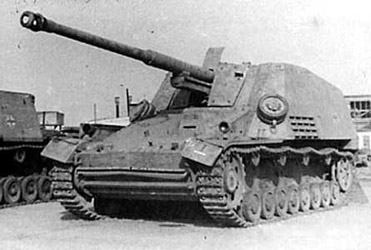 |
8.8 cm Pak 43/1 (L/71) auf Fahrgestell Panzerkampfwagen
III/IV (Sf) Hornisse/Nashorn
|
src: Site Panzer
Page von Reitsch
|
| Production |
|
| Period |
Built |
| 1943 |
345
|
| 1944 |
133 |
| 1945 |
16 |
En octobre 1942, un modèle en acier mou fut présenté à Adolf Hitler, qui en accepta le design et ordonna que la production débute en mai 1943. Début 1944, le compartiment du pilote fut modifié et surtout un nouveau canon, le 88 mm Pak 43/1 L/71 fut installé. Fin février 1944, Hitler ordonna que le nouveau modèle soir baptisé Nashorn (Rhinocéros). Bien que peu protégé, le Hornisse/Nashorn offrait une bonne mobilité au canon anti-char de 88. Comme pour le Hummel, ce panzerjäger souffrait d'un manque de place pour transporter des munitions (24 à 40 coups seulement). La superstructure ouverte n'était pas un avantage face aux mauvaises conditions atmosphériques et la protection de l'équipage était assurée par des couvertures de toile. Le Hornisse/Nashorn n'avait pas de mitrailleuse d'appoint prévue, ainsi l'équipage transportait généralement une MG34 ou une MG42 standard dans le compartiment de combat pour quant même assurer une défense locale. De février 1943 à mars 1945, seulement 474 Nashorns et 20 Hornisses furent produits par Alkett et Deutsche Eisenwerke à Tieplitz-Schonau.
In October 1942, a soft steel model was presented to Adolf Hitler, which accepted the design and ordered of it that the production begins in May 1943. At the beginning of 1944, the compartment of the pilot was modified and especially a new gun, the 88 mm Pak 43/1 L/71 was installed. At the end of February 1944, Hitler ordered that the new model evening baptized Nashorn (Rhinoceros). Although little protected, Hornisse/Nashorn offered a good mobility to the anti-tank gun of 88. As for Hummel, this panzerjäger suffered from a lack of place to transport ammunition (24 to 40 rounds only). The open superstructure was not an advantage vis-a-vis the bad atmospheric conditions and the protection of the crew was ensured by covers of fabric. Hornisse/Nashorn did not have an auxiliary machine-gun, thus the crew generally transported a standard MG34 or MG42 in the compartment of combat for as even ensuring a local defense. From February 1943 to March 1945, only 474 Nashorns and 20 Hornisses were produced by Alkett and Deutsche Eisenwerke in Tieplitz-Schonau.
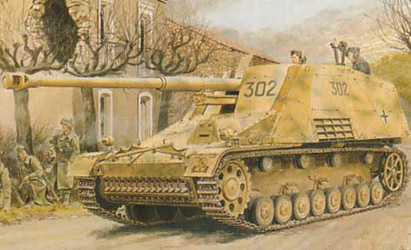 |
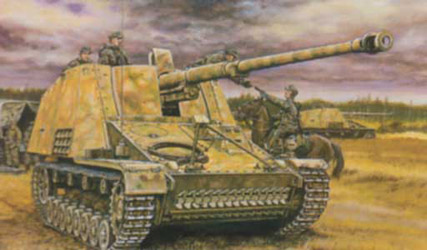 |
Hornisse
|
Nashorn |
88
mm Pak 43/1 L/71 Penetration of a shielding plate (mm) under a plunging angle of 30° |
|||||||
Ammo |
Weight |
Velocity |
100
m |
500 m |
1000
m |
1500 m |
2000
m |
| PzGr 39-1 | 10.2 kg |
1000 m/s |
203 |
185 |
165 |
148 |
132 |
PzGr 40-43 |
7.3 kg |
1130 m/s |
237 |
217 |
193 |
171 |
153 |
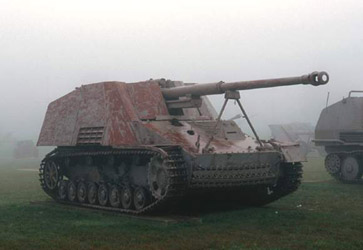 |
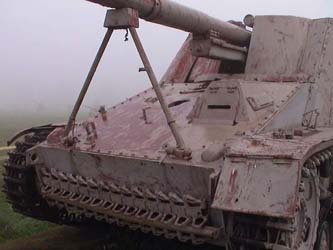 |
Nashorn
(Aberdeen Museum) |
|
|
|
|
Les deux modèles furent versés dans des schwere Panzerjäger Abteilungen et seront mis en service juste à temps pour l'Offensive de Koursk durant l'été 43, au sein du 655e sPzJagAbt et-ou du 560e sPzJagAbt. Malgré ses défauts ce modèle s'avéra être un redoutable chasseur de char grâce à son 88. Le Nashorn était avant tout un char d'embuscade ou d'affrontements à (longue) distance ce que lui permettait le très efficace 88 anti-char. Le Nashorn excellait donc dans un rôle défensif et non dans un rôle offensif que son faible blindage n'autorisait guère.
The two models were versed in schwere Panzerjäger Abteilungen and will be brought into service right in time for the Offensive of Koursk during summer 43, within the 655th sPzJagAbt and/or of the 560th sPzJagAbt. In spite of its defects this model proved to be a frightening tank destroyer thanks to its 88. Nashorn was mainly a tank for ambush or for confrontations at (long) distance what the very effective 88 anti-tank device allowed it. Nashorn thus excelled in a defensive role and not in an offensive role that its weak shielding hardly authorized.
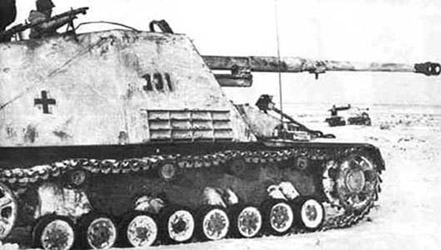 |
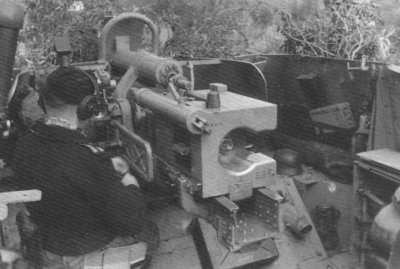 |
Nashorn with winter scheme. |
88 mm Pak breech |
src: Site Panzer
Page von Reitsch
|
Au total six schwere Panzerjäger Abteilungen furent créés, et furent mis en bataille sur tous les fronts. Chaque Abteilung était composé d'une compagnie de commandement et 2 à 3 compagnies de 4 pelotons chacune. Ces compagnies disposaient chacune de 14 à 17 Nashorns et chaque peloton disposait de 4 à 5 exemplaires. Petit à petit le Nashorn sera remplacé par une nouvelle génération de chasseurs de char, les Jagdpanzers (ou super chasseurs de char) beaucoup mieux protégés (par une superstructure entièrement close et un blindage plus conséquent). Le Nashorn restera tout de même en service jusqu'au terme du conflit et c'est d'ailleurs un Nashorn qui détruisit dans les derniers mois de la guerre, le seul char lourd M26 Pershing perdu par les Américains.
On the whole six schwere Panzerjäger Abteilungen was created, and was put in battle on all fronts. Each Abteilung was composed of a company of command and 2 to 3 companies of 4 groups each one. These companies laid out each 14 to 17 Nashorns and each group had 4 to 5 specimens. Gradually Nashorn will be replaced by a new generation of tank destroyers, Jagdpanzers (or super tank destroyers) much better protected (by an entirely closed superstructure and a more consequent shielding). Nashorn will remain all the same in service until the term of the conflict and it is besides Nashorn which destroyed in the last months of the war, the only heavy tank M26 Pershing lost by the Americans.
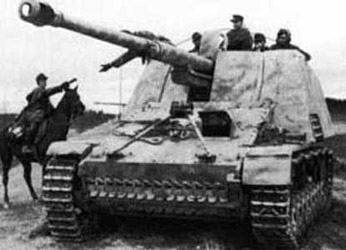 |
 |
| Message for the commander. |
Nashorn destroyed by a M10 of the 1st French
army in the plain of Colmar, the 7/2/1945. |
src: Site Lexikon
der Wehrmacht |
src: Tank Illustrated n°9 |
Notons qu'en 1944-1945, Krupp travailla sur une version spéciale du Jagdpanther dont la superstructure était montée à l'arrière comme celle du Jagdpanzer Tiger(P) Elefant et armée dans un premier temps du 88 mm Pak 43/1 et dans un deuxième temps du 128 mm Pak 80 L/55. Cette conversion baptisée Jagdpanther II ne vis cependant jamais le jour. Comme le Panther certains Jagdpanthers furent équipés du système de vision-nocturne (infra-rouge) pour les combats de nuit.
Note that in 1944-1945, Krupp worked on a special version of Jagdpanther whose superstructure was assembled to the back like that of Jagdpanzer Tiger(P) Elefant and army initially of the 88 mm Pak 43/1 and in the second time of the 128 mm Pak 80 L/55. This conversion baptized Jagdpanther II however never realized. As the Panther certain Jagdpanther were equipped with the night-vision system (infra-red) for the combat of night.
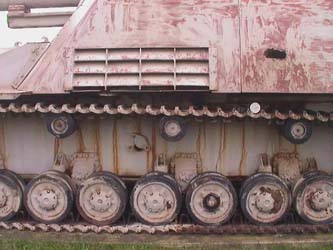 |
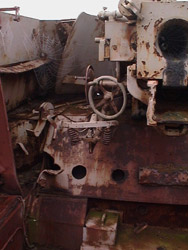 |
Nashorn
(Aberdeen Museum) |
|
|
|
|
Data |
Drawings |
Sources:
- Pz.Kpfw IV in action, Armor Number 12 (squadron/signal publications, inc.)
- Connaissance de l'Histoire (Hachette) - N°17 - " Les chars de combat allemands 39-45"
- Connaissance de l'Histoire (Hachette) - N°5 - " Véhicules blindés allemands 39-45"
- Les Blindés de la Seconde Guerre Mondiale (Atlas)
- Sturmartillerie & Panzerjäger 1939-1945 (Osprey Military) - New Vanguard N°34
- Site "Achtung Panzer" - http://www.achtungpanzer.com
- Site "WWII Vehicles" - http://www.wwiivehicles.com/germany/tank-hunters/nashorn.asp
- Site "Second World War Armour" - http://www.onwar.com/tanks/index.htm
